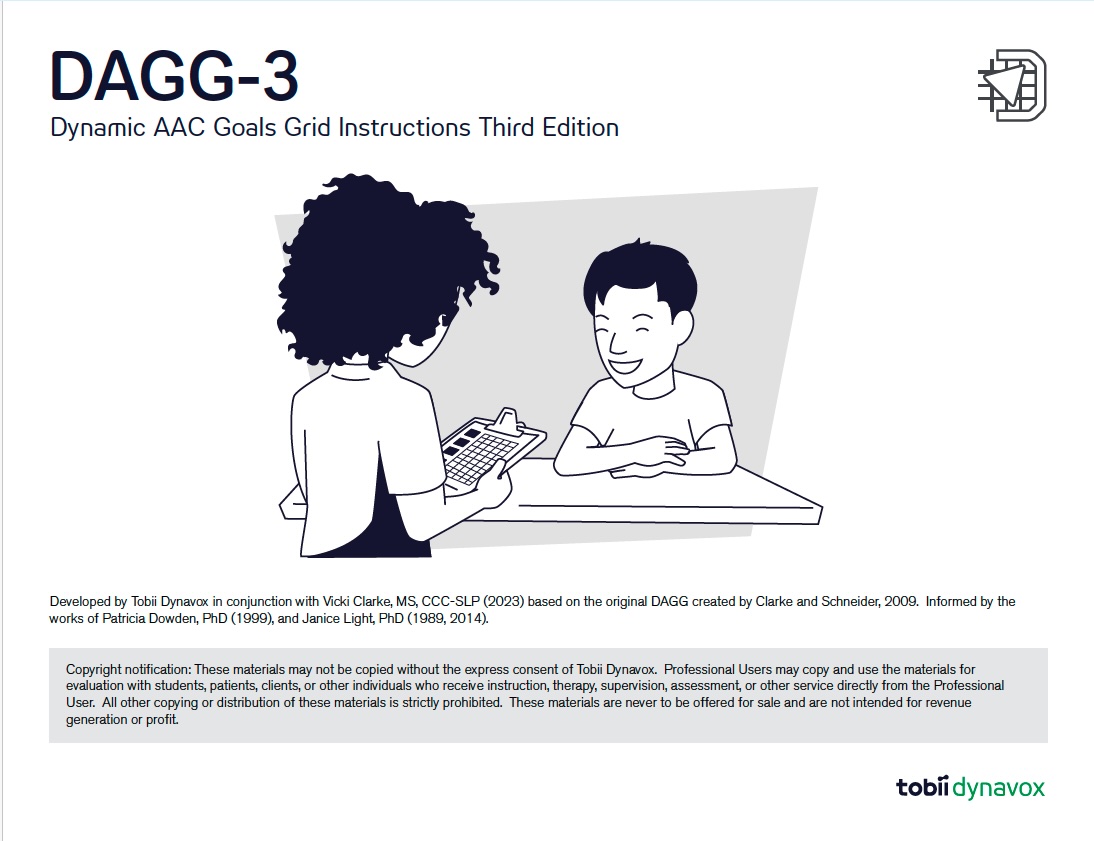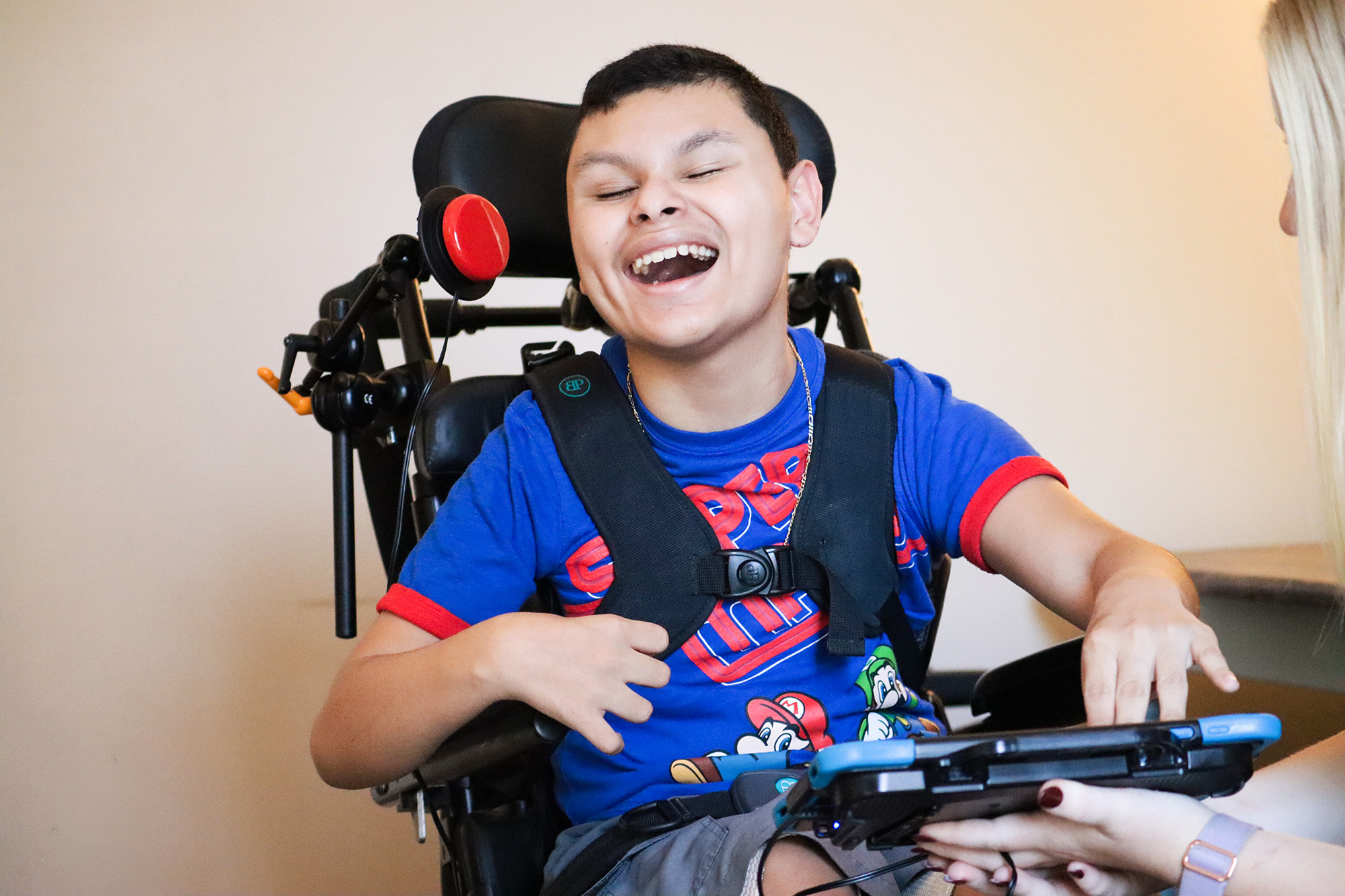By Vicki Clarke and Stephanie Ekis
As members of the DTA Schools team, we’ve had the privilege of helping educators, therapists, and families use the DAGG-3 (Dynamic AAC Goals Grid, Version 3) to guide communication assessment and goal setting.
The DAGG-3 was originally developed by Vicki Clarke, Holly Schneider, and a collaborative team at Tobii Dynavox, which also included Stephanie Ekis during her tenure there. Together, we designed it to help teams understand, measure, and support communication competence in individuals who use AAC.
Over the years, we’ve received thoughtful questions from the field—questions that reflect both the challenges and the commitment educators and therapists bring to supporting communication growth. Below, we’ve shared a few of the most common questions we hear, along with practical insights that may help you use the DAGG-3 with greater confidence and flexibility.
🧩 “My students don’t fit neatly into one Communication Ability Level. What should I do?”
That’s one of the most common (and encouraging!) questions we hear. Many students demonstrate communication skills across multiple ability levels, and that variation is a positive sign of growth.
When we developed the DAGG-3, part of our goal was to create a differentiated assessment across each of the competency areas—Linguistic, Operational, Social, and Strategic—so you should expect to see differences in a student’s profile.
For example, a student may be very socially engaged but not yet have the vocabulary they need. In that case, they might show higher ability in the Social and Strategic competencies while remaining more emergent in Linguistic (particularly vocabulary). Conversely, some students with autism may demonstrate strong spelling and vocabulary access but experience greater challenges with the social aspects of language.
This differentiation is intentional—it highlights areas of strength while pointing to areas where additional support is needed. A student might be at Level II for Linguistic skills but Level I for Operational skills, and that is perfectly valid.
Our advice: focus less on the labels and more on the goals. The ability levels are a guide, not a rulebook. Any goal not marked “GM” (Goal Met) remains available for instruction. Use the DAGG-3 as a roadmap, and let each student’s strengths and learning needs guide the route.
🧠 “How do we address the Social section for students on the Autism Spectrum?”
This is such an important question. Autistic students may experience challenges with social language, initiation, or perspective-taking—but that doesn’t mean they lack the desire to connect. Research and lived experience remind us that autistic individuals value relationships, even if those relationships are expressed differently.
The DAGG-3 helps identify where students are and how to build from there. For autistic learners, explicit instruction and visual supports are often key. We also encourage teams to broaden their definition of “social engagement.” Eye contact, for example, is not the only valid way to show connection. When we honor neurodiversity, we create space for authentic, meaningful interaction.
🗣️ “We use modeling and point prompts, but haven’t tried natural cues with our more emergent students. Should we?”
Yes—please do! Natural cues are foundational, even for students with significant communication needs.
A natural cue is something that people naturally do in a given situation without explicit prompting. For example, most neurotypical individuals, when entering a social setting, will greet others by speaking, making eye contact, or orienting their bodies toward those present. These are predictable, context-driven behaviors that create communication opportunities.
When we assess the supports our students need, it’s valuable to observe how they respond to these natural, predictable interactions. While we remain respectful of differences in social engagement—especially for autistic individuals—we also want to ensure that every student has a functional way to respond to natural environmental cues.
Using a least-to-most prompting strategy always begins with natural cues. Skipping this step can lead to prompt dependency, where communication only happens after a prompt. Modeling remains essential, but combining it with authentic opportunities for response promotes independence and real communication.
And one quick note: physical prompting (like hand-over-hand) is no longer considered best practice and has been removed from most modern prompting hierarchies.
🎯 “There are so many goals! How do we prioritize?”
We hear you! The DAGG-3 provides a wide range of goals, and it can feel overwhelming at first. A balanced approach works best.
Consider the importance of each of the four competencies—Linguistic, Operational, Social, and Strategic—and make sure your selected goals support progress across all areas of communication competence. Some students may need more intensive work in one domain, but lasting communication success depends on balanced growth.
We often recommend analyzing a student’s strengths and needs to determine whether to:
- build upon a current strength (to boost confidence and independence), or
- target an area of need that has high functional impact (to remove barriers to participation).
There’s no “right” or “wrong” set of goals—only thoughtfully chosen ones that reflect each student’s unique communication journey.
🌟 Putting It All Together: From Assessment to Action
The DAGG-3 isn’t just a checklist—it’s a living framework that helps teams think deeply about communication development. When used collaboratively, it brings clarity to what can often feel like a complex process. The key is to stay focused on growth, not perfection.
Each student’s communication journey is unique, and the DAGG-3 gives us a shared language to describe progress, celebrate strengths, and plan next steps. Whether you’re using it to guide IEP goals, inform intervention, or simply reflect on a student’s progress, remember that the ultimate goal is connection.
Communication growth happens when we create opportunities for students to be seen, heard, and understood. The DAGG-3 helps us make those opportunities intentional and achievable.
✨ Your Next Step:
Review your current students’ DAGG-3 profiles. Identify one area of strength and one area for growth—and design tomorrow’s lesson to support both. Small, consistent actions build meaningful change.
Written by Vicki Clarke and Stephanie Ekis, members of the DTA Schools team and contributors to the Dynamic AAC Goals Grid – 3rd Edition (DAGG-3), originally developed by Vicki Clarke, Holly Schneider, and the Tobii Dynavox AAC team. We’re dedicated to helping educators and therapists make AAC practical, purposeful, and empowering for every learner.


















